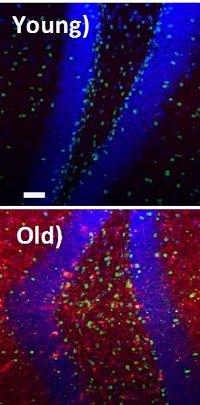 |
| Images of cells in the brain's hippocampus show that the growth factor TGF-beta1 (stained red) is barely present in young tissue but ubiquitous in old tissue.--Courtesy of UC Berkeley |
UC Berkeley investigators engaged in slowing down the aging process say they obtained some promising results in targeting a key culprit implicated in weakening tissues throughout the body.
The target is growth factor beta 1, or TGF-beta1, which is found in increasingly elevated levels as the body ages. The team at the California Institute for Quantitative Biosciences (QB3) hit TGF-beta1 in mice on two fronts: They used a gene therapy to insert a TGF-beta1 blocker into the hippocampus and they injected an existing cancer drug--a small molecule Alk5 kinase inhibitor that also knocks down the target--in the blood.
"The key TGF-beta1 regulatory pathway became reset to its young signaling levels, which also reduced tissue inflammation, hence promoting a more favorable environment for stem cell signaling," said Irina Conboy, who's been investigating this pathway for the past decade. "You can simultaneously improve tissue repair and maintenance repair in completely different organs, muscle and brain."
Significantly, QB3 is also partnered with Google's ($GOOG) Calico, which is making aging research its central focus.
This is by no means a magic bullet, the team adds. They are pursuing multiple pathways involved in the way adult stem cells age, triggering a physical and mental decline. But the work does help demonstrate that if you find multiple ways to hit this particular pathway, you can trigger a broad, positive response at more than one level.
"We established that you can use a single small molecule to rescue essential function in not only aged brain tissue but aged muscle," said co-author David Schaffer, director of the Berkeley Stem Cell Center and a professor of chemical and biomolecular engineering, in a statement. "That is good news, because if every tissue had a different molecular mechanism for aging, we wouldn't be able to have a single intervention that rescues the function of multiple tissues."
"The challenge ahead is to carefully retune the various signaling pathways in the stem cell environment, using a small number of chemicals, so that we end up recalibrating the environment to be youth-like," Conboy said. "Dosage is going to be the key to rejuvenating the stem cell environment."
- here's the release